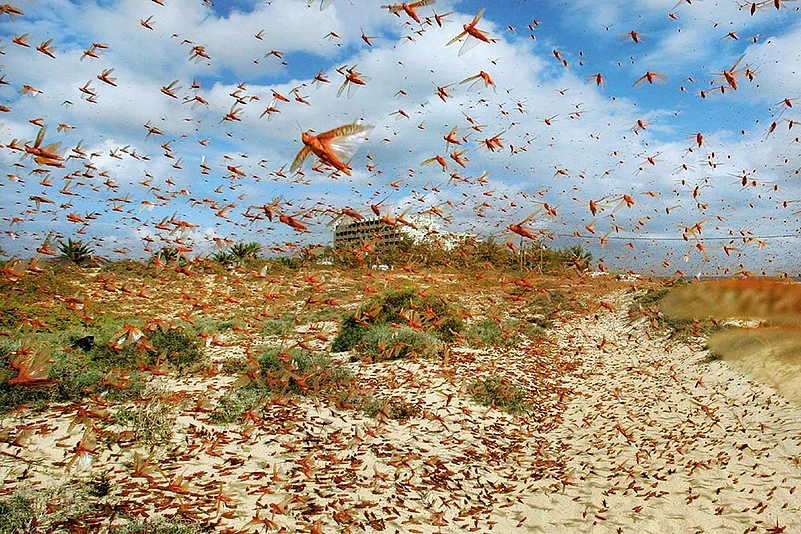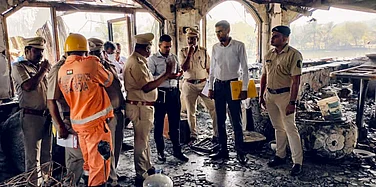A common enemy —tiny but devastating as a swarm—has brought two hostile, nuclear-armed neighbours together to plot and unleash a joint fight. The foes in question are locusts (tiddi in Hindi) from Africa, the breeding ground of the pest that finds mention in early Sanskrit texts, the Bible, Egyptian tomb hieroglyphics, and Amharic folk songs of Ethiopia. The protagonist of immeasurable pestilence has flown this year from the Horn of Africa to Iran en route to Pakistan, and Barmer and Jaisalmer regions of Rajasthan’s Thar desert. Yes, Pakistan and India—neighbours not at talking terms since the Indian Air Force’s strikes on terrorist camps in Balakot. The ties plummeted further with the BJP-led Union government’s latest move to strip Jammu and Kashmir of its autonomy.
Yet, scientists and agriculture experts of both nations have been collaborating since May this year on the “little terrorists” threatening to devour everything in their path, flagging a possible threat to crops and food security. The region recorded a locust outbreak nearly a quarter of a century ago and the devastation was monstrous. Union agriculture minister Narendra Singh Tomar said in a written reply to Parliament on July 23 that officials on both sides of the border were trying to contain the invader that has already damaged crops in Pakistan.
“Recently, two joint border meetings were held on June 19 and July 17, 2019, at Munabao (India) and Khokhrapar (Pakistan) respectively. Both countries shared the locust infestation information and control measures taken by them and agreed to continue the control operations in their territories,” Tomar said.

To monitor the incursion, meetings will be held every month for the six months that constitute the “locust season”—which, according to experts, begins with the rain. “Good rain along the Red Sea coastal plains in Eritrea and Sudan have allowed two generations of breeding since October, leading to a substantial increase in locust populations and the formation of highly mobile swarms,” the UN Food and Agriculture Organisation said. At least one swarm had crossed to West Asia, went unchecked in war-ravaged Yemen from where it moved to the UAE and southern Iran. The pests kept pressing on before reaching Balochistan and Sindh, and finally crossing the border into Jaisalmer, Bikaner and Barmer.
The outbreak has threatened the cotton crop in Pakistan across 246,000 hectares, which accounts for about 23 per cent of its entire crop sown and whose products account for over 40 per cent of the country’s economy. In India, the agriculture minister wrote that 19,153 hectares in Jaisalmer, Barmer, Bikaner, Jalore, Banaskantha and Jodhpur had been sprayed with insecticides till July 17. The desert areas of Punjab, Haryana and Rajasthan form summer breeding grounds for the insect between June and November. It is said that apart from neem and shisham, locusts do not spare any plant.
The desert locust (Schistocerca gregaria), weighing a mere two grams, is considered the “most dangerous migratory pest” in the world, according to Keith Cressman, a senior locust forecasting officer with the UN. Adult locust swarms—numbering billions and triggering a cloud-like effect when airborne—can fly up to 150 km per day with the wind and consume roughly their own weight in fresh food a day. They multiply 16-20 times over three months under optimal conditions. A small swarm eats as much in one day as about 35,000 people, reports say. “The swarm looks like an army. The sky darkens when they attack and completely clean up everything in their path,” agriculture expert Devinder Sharma tells Outlook.
The last massive upsurge took place in 2003-04, when locust swarms spread to 23 countries in Africa and West Asia. It took $500 million worth of insecticides sprayed across 13 million hectares over two years to control. Swarms have been reported on the Italian island of Sardinia this summer, where the pests have destroyed crops, grazing pastures and infested houses in the worst invasion since the end of World War II.
The Locust Warning Organisation, which has been monitoring the current crisis, was formed in India in 1939 after a plague which peaked in 1929. In a research paper for Current Science in 1935, Y. Ramachandra Rao wrote: “Indeed, the Indian cultivator, be he Moslem or Hindu, often expresses himself unwilling to lift his hand against these pests, ruinous though they may be to his food crops, as he believes the visitation to be a manifestation of Divine Wrath, which he dare not resist.”
This time around, control measures are underway. “There hasn’t been crop damage. When the initial incursion happened, the sowing hadn’t happened; the locusts were mostly in the desert and barren areas,” says Suwa Lal Jat, joint director at the department of agriculture, Rajasthan. Jat mentions that there were reports of a new swarm in Jaisalmer between August 10 and 11, but it wasn’t a “major” worry. “At present, the situation isn’t serious or dangerous…64,000 hectares have been sprayed with chemicals,” he says.
We were probably lucky. There wasn’t much crop in the fields at the time the locusts arrived. “The insect needs moisture to populate, but Jaisalmer, Barmer and Bikaner didn’t get much rainfall this year,” says Pradeep Pagaria of the Krishi Vigyan Kendra in Barmer. In his paper, Cressman explains that locusts take advantage of unusually high rainfall and “multiply rapidly”.
The government has deployed vehicles fitted with insecticide-spraying machines for vulnerable areas. Agriculture expert Sharma remembers the time he covered the last big incursion in the mid-1990s in Rajasthan and Haryana as a a newspaper correspondent. “Back then, the attack was so devastating that newspapers had it on their front pages for many days. This time, the media has not even talked about it much,” he says. The blackout perhaps could be attributed to more pressing engagements—say, guided missiles rather than misguided insects.


























